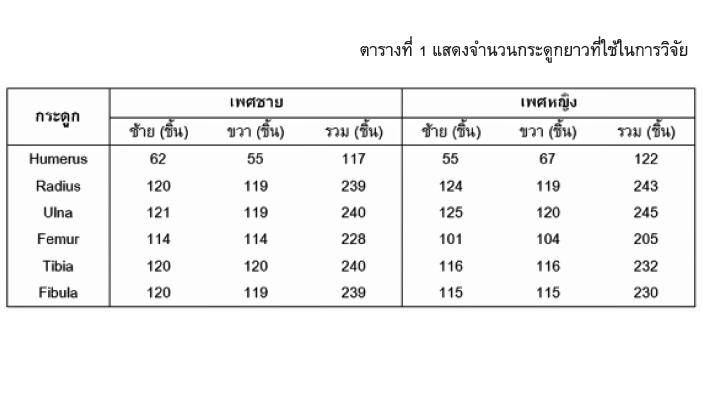
การประเมินส่วนสูงคนไทยในปัจจุบัน จากความยาวของกระดูกยาว
ESTIMATING THE STATURE OF MODERN THAIS FROM THEIR LONG BONES
โดย อารยา เสงี่ยมพงษ์, ทนงศักดิ์ เลิศพิพัฒน์วรกุล, สรรใจ แสงวิเชียร, นฤพล หวังธงชัยเจริญ / By Natthamon Pureepatpong, Arraya Sangiampongsa, Tanongsak Lerdpipatworakul, Sanjai Sangvichien, Naruphol Wangthongchaicharoen
Damrong Journal, Vol 11, No.1, 2012
บทคัดย่อ:
บทความนี้นำเสนอสมการประเมินส่วนสูงคนไทยปัจจุบัน จากความยาวของกระดูกยาวส่วนแขนขา ที่ได้จากการศึกษาร่างมนุษย์ชาวไทยปัจจุบัน(วัยผู้ใหญ่) จำนวน 275 ร่าง อายุระหว่าง 25-97 ปี ที่เจ้าของร่างได้บริจาคเพื่อการศึกษาแก่ภาควิชากายวิภาคศาสตร์ คณะแพทยศาสตร์ศิริราชพยาบาล มหาวิทยาลัยมหิดล โดยการวิเคราะห์ทางสถิติด้วยโปรแกรมคอมพิวเตอร์(Microsoft Excel 2003 และ Minitab 14) เพื่อศึกษาสถิติพรรณนา ทดสอบความสัมพันธ์ (ที่ระดับนัยสำคัญ 0.05) และวิเคราะห์การถดถอย ระหว่าง 2ตัวแปร คือ ส่วนสูงของมนุษย์กับความยาวของกระดูกยาวส่วนแขนขา จำนวน 6 ชิ้น ได้แก่ Humerus, Radius, Ulna, Femur, Tibia และ Fibula ทั้งนี้การศึกษาจะจัดแบ่งข้อมูลออกเป็น 3 กลุ่ม ได้แก่ เพศชาย เพศหญิง และรวมเพศ (เพศชาย+เพศหญิง) เพื่อหาสมการประเมินส่วนสูงของแต่ละกลุ่มและเป็นประโยชน์ต่อการใช้งานต่อไป
ผลการศึกษาพบว่าความยาวของกระดูกยาวส่วนแขนขาทั้ง 6 ชิ้นมีความสัมพันธ์กับส่วนสูงอย่างมีนัยสำคัญทางสถิติ (ที่ระดับ 0.05) และเมื่อวิเคราะห์การถดถอยเพื่อหาสมการประเมินส่วนสูงพบว่ากระดูกส่วนขาและแขนที่ต่อกัน 2 ชิ้น โดยเฉพาะกระดูก Femur (max) + Tibia (max) มีค่าความแม่นยำในการใช้ประเมินมากกว่ากระดูกชิ้นเดียว ส่วนกระดูกชิ้นเดียวที่มีค่าความแม่นยำในการใช้ประเมินส่วนสูงมากที่สุด คือกระดูก Femurนอกจากนั้น ยังพบว่าในเพศชายกระดูกแขนสามารถใช้ประเมินส่วนสูงได้ดีกว่ากระดูกส่วนขา (ยกเว้น Femur) ในขณะที่เพศหญิงความยาวของกระดูกส่วนขาสามารถใช้ประเมินส่วนสูงได้ดีกว่ากระดูกส่วนแขน
ABSTRACT:
The lengths of long bones of adult skeletons are commonly used to estimate stature. The regression equations used for calculating stature were established by equating the relationship between the height and the length of long bones. We measured 275 adults, ranging in age from 25 to 97 years old. The length of six long bones: humorous, radius, ulna, femur, tibia and fibula, were used in our calculations. Both the femur and tibia were measured by 2 different methods: maximum length and anatomical length. Microsoft Excel 2003 and Minitab 14, a statistics based computer software program, were used to calculate and establish the regression equations for stature estimations of three groups: male, female and unknown sex (α= 0.05). The results suggest that the length of two long bones, especially femur (max) + tibia (max), provides the highest levels of accuracy for stature estimation in all three groups. For a single long bone, the femur is the most accurate for every group. Overall, the results indicate that the upper extremities more accurately present the stature than the lower extremities (except femur) for males. Alternatively, the femur, tibia and fibula provide the most accurate stature estimations for females.











